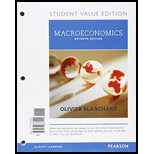
a
To show:Effect on IS and LM curve due to decrease in the expected future real interest rate.
a
Explanation of Solution
A decrease in expected future interest rates will cause the IS curve to shift to the right. It will also cause the LM curve to shift downwards. Since expectations of future interest rates will affect current variables, the LM curve would shift downwards in much the same way as it would under monetary expansion. The IS curve will shift to the right, causing output to increase and the current interest rate to decrease.
Introduction:
IS curve is a graphical representation of goods
LM curve is a graphical representation of
b)
To show:Effect on IS and LM curve due to an increase in the current real policy interest rate
b)
Explanation of Solution
Increasing the current money supply would shift the LM curve downwards. If the expectations of financial market participants do not change, the IS curve will remain the same and output won't change by much. If people expect the future interest rates to change, the IS curve right shift to the right, increasing output by a significant amount.
Introduction:
IS curve is a graphical representation of goods market equilibrium showing combination of interest rate and output level.
LM curve is a graphical representation of money market equilibrium showing combination of interest rate and output level.
c)
To know:Effect on IS and LM curve due to an increase in expected future taxes.
c)
Explanation of Solution
An increase in future taxes will shift the IS curve to the left. The current output will decrease as consumers will have less disposable income to spend on consumption. This will lead to a lower level of output.
Introduction:
IS curve is a graphical representation of goods market equilibrium showing combination of interest rate and output level.
LM curve is a graphical representation of money market equilibrium showing combination of interest rate and output level.
d)
To find:Effect on IS and LM curve due to decrease in expected future income.
d)
Explanation of Solution
A decrease in expected future income will have the same effect as in part (c). The IS curve will shift to the left and lead to a decrease in consumption. Again, a decrease in future income will cause consumers to have less disposable income, leading to a lower level of output.
Introduction:
IS curve is a graphical representation of goods market equilibrium showing combination of interest rate and output level.
LM curve is a graphical representation of money market equilibrium showing combination of interest rate and output level.
Want to see more full solutions like this?
Chapter 16 Solutions
Macroeconomics, Student Value Edition Plus MyLab Economics with Pearson eText -- Access Card Package (7th Edition)
- The problem statement never defines whether the loan had compound or simple interest. The readings indicate that the diference in those will be learned later, and the formula used fro this answer was not in the chapter. Should it be assumbed that a simple interest caluclaton should be used?arrow_forwardNot use ai pleasearrow_forwardNot use ai pleasearrow_forward
- Not use ai pleasearrow_forwardSuppose there is a new preventative treatment for a common disease. If you take the preventative treatment, it reduces the average amount of time you spend sick by 10%. The optimal combination of Z (home goods) and H (health goods). both may increase both may increase or one may stay the same while the other increases. both may decrease H may increase; Z may not change Z may increase; H may decreasearrow_forwardIn the Bismarck system,. may arise. neither selection both adverse and risk selection ☑ adverse selection risk selectionarrow_forward
 Economics (MindTap Course List)EconomicsISBN:9781337617383Author:Roger A. ArnoldPublisher:Cengage Learning
Economics (MindTap Course List)EconomicsISBN:9781337617383Author:Roger A. ArnoldPublisher:Cengage Learning


 Macroeconomics: Private and Public Choice (MindTa...EconomicsISBN:9781305506756Author:James D. Gwartney, Richard L. Stroup, Russell S. Sobel, David A. MacphersonPublisher:Cengage Learning
Macroeconomics: Private and Public Choice (MindTa...EconomicsISBN:9781305506756Author:James D. Gwartney, Richard L. Stroup, Russell S. Sobel, David A. MacphersonPublisher:Cengage Learning Economics: Private and Public Choice (MindTap Cou...EconomicsISBN:9781305506725Author:James D. Gwartney, Richard L. Stroup, Russell S. Sobel, David A. MacphersonPublisher:Cengage Learning
Economics: Private and Public Choice (MindTap Cou...EconomicsISBN:9781305506725Author:James D. Gwartney, Richard L. Stroup, Russell S. Sobel, David A. MacphersonPublisher:Cengage Learning





